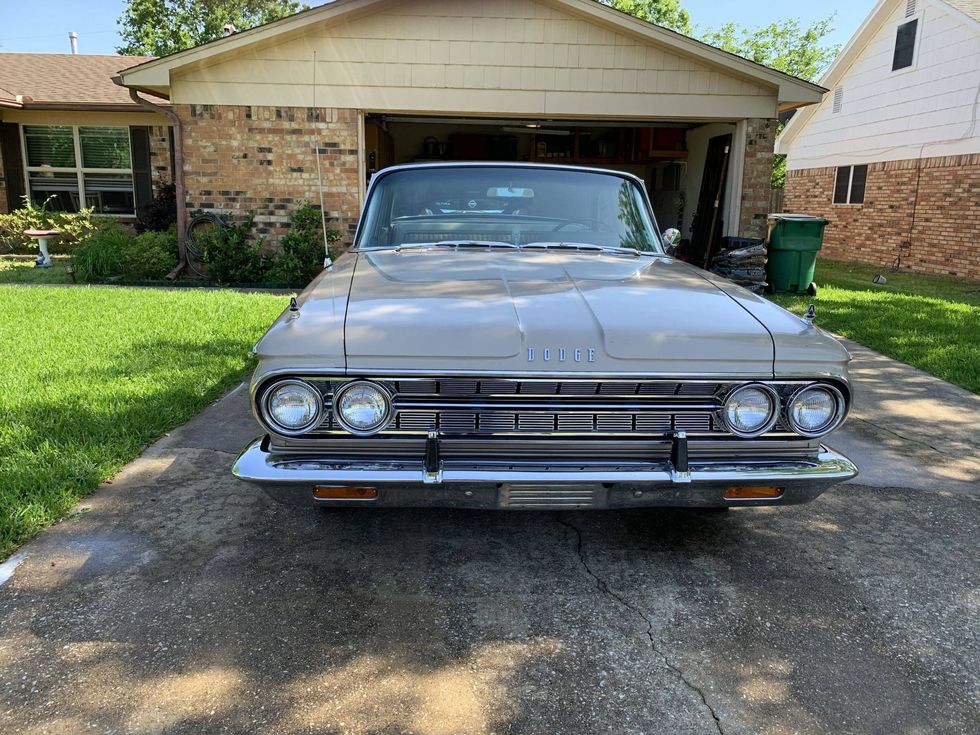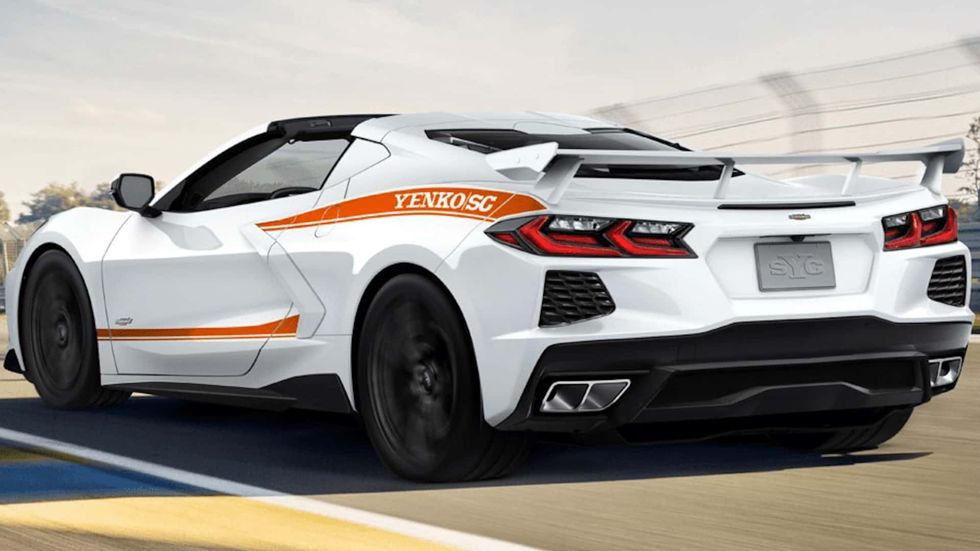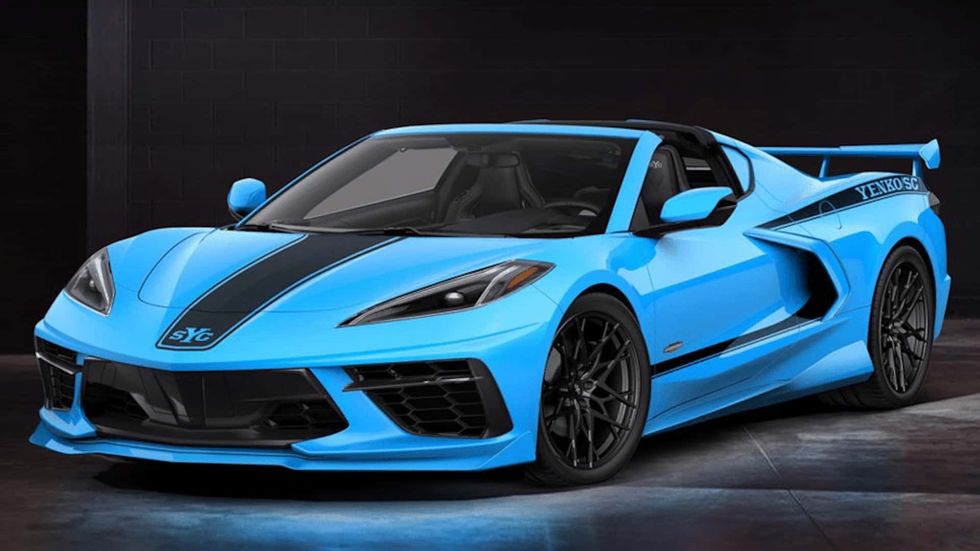
Buy
Resources
Entertainment
Magazine
Community
In This Article
Category:
Car Culture
If Syd Mead were as consumed by the pursuit of aerodynamic perfection as Alex Tremulis and stripped of any and all regard for design precedent, the result would come relatively close to the works of industrial designer and futurist Luigi Colani, whose hypercurved designs have shown far-flung automotive futures, and who died this week at the age of 91.
Born in August 1928 in Berlin, Colani - who changed his first name from Lutz while in his late Twenties - studied sculpture and painting in Berlin and later aerodynamics in Paris. In 1953, he found work at McDonnell Douglas in California, but he soon switched to automobiles, penning designs for Fiat and others as a styling consultant. At the time, his designs remained largely grounded and straightforward, though with hints of the bio-mimicry style that he would later come to adopt.
Take, for instance, the Alfa Romeo Giulietta that Carlo Abarth commissioned Colani to design and build in 1957. From the windshield back, it looks rather like Abarth's double-bubble Zagato-bodied 750, but ahead of the windshield it stretches forward and down, as if Colani were designing a shark-inspired Corvette for the late Sixties. In 1959, he followed the Alfa with a take on the BMW 700, another small sports car with a severely tapered front end that some claim was the first plastic monocoque car.
"Why should I join the straying mass who want to make everything angular?" Colani wrote on his website, defending his design philosophy. "I am going to pursue Galileo Galilei's philosophy: my world is also round."
As Colani himself boasted, his designs were always decades ahead of other industrial designers. "People need at least 20 years to come up to my level that I have at the moment," he told CNN in 2014. "All kinds of transport must be done but better," he says. "We have the knowledge today, we have the technology today, we have the materials today. But we don't have the brains and the companies who should say yes to good ideas. There are too many conservative brains in positions where they should not be conservative. They should go ahead to give the youngsters jobs, ideas and freedom to think." For an idea of how far-out some of Colani's ideas were, take a look at the gallery of cars designs on his website.
Perhaps his last hurrah for production-based auto designs came in 1960, when Colani introduced his GT fiberglass-bodied kit car. Designed to use Volkswagen mechanical components, it sat so low, the Volkswagen four-cylinder engine needed its own bubble for the bodywork to contain it. He reportedly sold 1,700 of the kits.

While Colani turned his attention to boat and furniture design - and over the years has designed everything from kitchen appliances to cameras to coffins - he often returned to auto design over the years, though with wilder and less easily produced concepts. Perhaps his most celebrated concept, the 1970 Miura Le Mans concept, started out as an ordinary Lamborghini Miura that Colani stripped of all but its mid-engine drivetrain. While he added some bodywork that, at the rear, wouldn't look out of place on a Can-Am car, he eschewed a traditional ladder frame or even a monocoque chassis for a two-part design that hinged above the transverse V-12. The drivetrain inhabited its own pod while the two passengers reclined between the two non-steerable front wheels and under the low, laid-back canopy of the forward pod.
The same year, he took on his C-112 concept, a design inspired by the Mercedes-Benz C-111, though sleek and laid back enough to cut through the air with a coefficient of drag of 0.2. Not long after, he applied that focus on extreme aerodynamics to semis and other large trucks in an effort to reduce fuel consumption. His ultimate achievement in building fuel-efficient vehicles came in 1981 when he built a stock-engine, stock-chassis Citroen 2CV capable of covering 100 kilometers on just 1.7 liters of gasoline (or about 138 miles per gallon).
Later in the Eighties, he took to speed records as proof of his aerodynamic design capabilities. His Colani-Egli MRD-1 land-speed motorcycle, which incorporated its upper fairings into the rider's suit, set a land-speed record at more than 170 MPH with a top speed of 198 MPH. Then in 1989, he introduced Automorrow, a series of 13 vehicles that Colani designed and built to set land-speed records at Bonneville. Among them was the Ferrari Testa d'Oro, a twin-turbocharged take on the Testarossa with an uninterrupted canopy line stretching from just above the front splitter to the massively upswept tail, incorporating vestigial bumps reminiscent of the double-bubble Alfa Romeo he designed 30 years prior.
Though galleries began to display Colani's work toward the end of the Seventies, Colani found his techno-utopian optimism for the future out of favor during the Eighties, leading him to leave Europe for Japan and, later, China, where his ideas found more support. Only with the turn of the Twenty-First Century - and with images of his fuel-saving semis circulating on the Internet - did the West re-discover Colani, leading to retrospectives of his work in Germany.
Other noteworthy automotive designs of his attempted to bring back the Horch brand (1996, with a cheeky hood mascot hanging on for dear life); cash in on the neoclassic craze (1976, with the L'Aiglon); and update the boxiest of boxy cars, the Lada (1987, the Gorbi).
Colani died Monday in Berlin after a long illness.
Recent
Specialty Vehicle Engineering
Specialty Vehicle Engineering (SVE) has done it again with its latest power-adding limited-edition build, this time for the 2024 Chevrolet Corvette. The latest Yenko/SC sports car received some serious upgrades for the sizeable boost in performance that Yenko-badged vehicles are known for.
The Yenko 2024 Chevrolet Corvette is powered by a twin-turbocharged 6.2-liter LT2 V8 engine capable of 1,000 horsepower, around double the power of a stock Corvette. Depending on the 2024 Corvette’s trim level, the factory power ratings run between 490 to 670 horsepower.
Releasing 1,000 horses out of the stable was made possible by the addition of two 58-millimeter water-cooled turbochargers, but before the turbos were tacked on, the V8 engine received some upgrades of its own. An ARP high-strength head, a forged steel crankshaft, forged H-beam rods, forged aluminum pistons, and a proprietary camshaft strengthen the internals, while a custom intake manifold, CNC ported high-flow cylinder heads, an upgraded fuel system, and a custom tune further opens up the L2 to all the added power. SVE couldn’t stop there: The Corvette’s eight-speed dual-clutch gearbox was also upgraded to withstand the extra power and blast it to the rear wheels.
SVE tops off the upgraded powertrain with custom valve covers. In the rear, distinctive exhaust tips are added and are available in silver or black. Yenko-badged brake calipers can be had in select colors, with the standard option being red. Three different designs of staggered 19-inch front and 20-inch rear wheels are also available in various finishes. Inside of the new Yenko Corvette are embroidered logos on the headrests and floormats, characteristic of the company’s other Yenko offerings.
SVE is offering its Yenko Corvette in coupe or convertible body styles, with any of the currently available factory Corvette color choices. Nine colors are available for the SYC graphics, plus the addition of a tenth carbon fiber option.
SVE confirms it will build just 10 Yenko/SC Corvettes for the 2024 model year, but that production number will increase to 50 for 2025. The Yenko/SC Corvette package starts at $99,995, not including the initial cost of purchasing a new Corvette.
Are Yenko muscle cars more your style? Check out the latest supercharged 2024 Yenko/SC Chevrolet Camaro that makes more power than a supercar.
Keep reading...Show Less
We can’t help surfing online classifieds to search for deals and then getting caught up in daydream builds each time we come upon something interesting—that’s standard behavior for gearhead car enthusiasts. For those of us on staff here at Hemmings, having collector car classifieds and an online auction site under the same virtual roof just encourages those tendencies. So, when the end-of-month report of sold vehicles hits the inboxes around here, there are always some completed sales that jump out and make some of us wish we’d gotten in on the bidding action.
Every so often we'll hear from someone who thinks the Hemmings Marketplace only caters to high-end collector cars, and the players with the budgets to navigate in that realm, that really isn’t the case—there are always deals to be had among the offerings, some that really stand out. If fact, when the roundup of April sales came out recently, I noticed several vehicles that made me think I should have been paying more attention while bidding was still going on. Here are a few highlights that really got the wheels spinning in my head with some theoretical projects.
1974 GMC Sierra Grande
<p>This truck was the vehicle responsible for making me delve deeper into the April sales listings to see what else I had missed. The weathered “Bright Green Iridescent” paint grabbed me and set the tone for a rig that looks like a ‘70s drag racer’s dream hauler from the days when dually pickups were something new and “3+3” crew cabs were still somewhat unusual. That “double-decker” bed topper, paint matched of course, with its Vista Cruiser-style windows (or were they inspired by that ‘70s big-rig icon, the Kenworth Aerodyne?) lends hard to the old-school drag race hauler vibe this thing is putting out hard. More nuanced evidence lies with the high-trim Sierra Grande package and the Camper Special equipment, ordered for a truck that was going to do some travelling, but not with a camper</p><p>Naturally, this one has a 454 and a TH400 automatic, and the listing detailed that the current engine was a replacement, though the original would also be included. For gearheads, that’s a nice bonus, as an early ‘70s 454 core is always good to have around. However, once the daydreaming got underway, a few of us in the office began to envision this hauler with a transplanted 8.1-liter Chevy big-block from the early 2000s backed with an Allison five-speed automatic—both of which could be plucked from a rusted and retired work truck one of our friends currently has. That relatively low-buck swap would make this thing a killer retro-styled tow rig for interstate travel. The bonus would be having not one, but two 454s to play with for hot rod projects. </p><p>That bright green paint was a bold choice even amid the flash of the ‘70s, and with a truck this large it screams of the period in a very cool way. The years of seasoning that left the aforementioned “patina” finish will make it all the more appealing to today’s classic truck fans. </p><p>That sort of western sunbaked finish is often accompanied by a similarly baked interior, but not here. The seller makes mention of reupholstery work done about a dozen years ago, and though the listing describes sun fading and cracking on parts of the seat covers, it also said there were no cracks in the dash pad, and the door panels looked to be in good shape too. </p><p>We couldn’t believe this unit went for just $5,600, and several of us were kicking ourselves for not bidding. Man, this thing is cool. </p><p><a href="https://www.hemmings.com/auction/1974-gmc-sierra-grande-huntsville-al-224267/sold" target="_blank" rel="noopener noreferrer">https://www.hemmings.com/auction/1974-gmc-sierra-grande-huntsville-al-224267/sold</a></p>




1964 Dodge 880
<p>Back in 1964, this Dodge 880 four-door sedan would have seemed like a run-of-the-mill car, blending in with the scores of other sedans on the road and looking mostly contemporary, though maybe a touch dated. But today, despite it being a body style that has traditionally been eschewed by enthusiasts, this Dodge would certainly turn heads. It’s not even a hardtop, yet this Dodge’s period style and excellent condition ought to allow it to get a pass even from enthusiasts who might normally dismiss it as a “more door.”</p><p>There wasn’t a lot of background given in the description, but looking over the photos, you can see that the back seat still wears a vintage clear-plastic seat cover, likely installed when the Dodge was new and almost certainly responsible for the outstanding condition of the upholstery up front, where we’ll guess another more deteriorated clear cover was recently removed. The pushbutton automatic and dash-mounted rearview mirror were the norm for Chrysler Corp cars at that time, but both are oddities that now add to this Dodge’s quirk factor. The 361-cu.in. V-8 has a displacement that probably sounds unfamiliar to many enthusiasts, but it was a member of Chrysler’s B-series of low-deck, “big-block” V-8 engines, along with the widely recognized 383. And if the accompanying video clip is accurate, this 361 runs like a Swiss watch. </p><p>Overall, most of the mechanical parts on this Dodge ought to be sourced somewhat easily, from that engine to the TorqueFlite transmission, the 8-3/4 rear axle, and many of the chassis parts, since this model was built on the Chrysler C-body platform. All of this should make it a great classic to use as a regular driver, and for the sale price, it would be hard to go wrong. </p><p><a href="https://www.hemmings.com/listing/1964-dodge-880-447036/sold" target="_blank" rel="noopener noreferrer">https://www.hemmings.com/listing/1964-dodge-880-447036/sold</a></p>




1971 Alfa Romeo Spider
<p>If you’ve ever owned, or even just looked into owning, a vintage Alfa Romeo, you know what a deal this sale was. The 1971 Alfa Spider was among the earliest of the “square-tail” body style that lasted up into the early ‘80s, though of these, the earliest cars are the most prized for their slender bumpers with stainless steel trim. For North American Spiders, the ’75-on models had large, rubber-clad bumpers to cope with 5-mph laws, along with a steadily expanding array of smog-coping alterations. This particular Spider was partially dismantled and offered as a project vehicle, but even at that, it was a bargain. </p><p>All Alfas of this period were highly susceptible to corrosion, and it’s pretty standard to see rotten rocker panels, missing spare tire wells, and ventilated floorpans, but this one seems to have avoided the usual deterioration. The seller claimed the car had spent much of its life in Arizona, and that’s what it would take for one of these to avoid oxidation as well as this one seems to have managed. The baked paint and crumbled seat upholstery and foam support the notion that the Spider spent its time in the desert. This very early square-tail also had the desirable 1750-cc version of Alfa’s classic twin-cam four-cylinder; the 2,000-cc version replaced the 1750 shortly after, but many members of the “Alfisti” will say the 1750 is the favored configuration, seeming "snappier" and more willing to rev. </p><p>The engine and transmission were present, as was the North American-spec SPICA mechanical fuel-injection. Most Alfa enthusiasts prefer side-draft carburetors, as Alfa intended (the carbs wouldn’t pass American emissions regs), but the SPICA system is robust and reliable when functioning—hopefully this one hasn’t suffered too badly from decades of storage. </p><p>The listing said the seat frames and top frame were also present, though it offers no mention of some of the smaller trim, like those coveted slim bumpers. This car even came with a clean title and some other factory documents. Though there is clearly plenty of work ahead to put this Spider back on the road, the buy-in for this project would make it easy for someone to invest some more—haggard parts cars for this model usually cost more. Someone scored here. </p><p><a href="https://www.hemmings.com/auction/1971-alfa-romeo-1750-berthoud-co-985603/sold" target="_blank" rel="noopener noreferrer">https://www.hemmings.com/auction/1971-alfa-romeo-1750-berthoud-co-985603/sold</a></p>




1955 Ford Fairlane
<p>Okay, another four-door sedan here, and one that would have once been among the most commonly seen cars on the road. But that time was nearly 70 years ago; today, this Ford would stand out in any automotive gathering. Helping it garner attention is that very period turquoise and white two-tone paint, trimmed with thick, bright-metal moldings, looking almost like a caricature of a 1950s American car.</p><p>The listing says this Ford has the 292-cu.in. version of the Y-block V-8 and an automatic transmission, so it ought to be fairly easy to drive and capable of hanging with modern traffic in most situations. However, very little was offered in the listing, other than to say that the car has been off the road since 2000 and will need its fuel tank installed in order to run. That tank is said to be new, so perhaps a rusted original tank contributed to the Ford being set up for a time. </p><p>The few interior photos show what appears to be nice upholstery, with a textured pattern that also screams ‘50s in an appealing way. No alterations from stock are evident in the limited view inside. Meanwhile, under the hood looks more like a typical workaday car or truck—dirty and with very aged paint, but in a way that appears functional and un-messed with. If it runs, the new owner can tackle the engine-bay sprucing as a relatively simple renovation project. </p><p>For anyone wanting a ‘50s car to cruise for low-commitment fun, this Ford would provide an excellent entry point. For the selling price, some further investment could still be made that might feasibly be recouped later if the car was sold in running, driving condition. Well bought here. </p><p><a href="https://www.hemmings.com/listing/1955-ford-country-sedan-407091/sold" target="_blank" rel="noopener noreferrer">https://www.hemmings.com/listing/1955-ford-country-sedan-407091/sold</a></p>




Keep reading...Show Less









